Dai Kam Jie (Bride's Chaperone) Explains the Contemporary Take on Traditional Weddings: A Rich Blend of Heritage and Heartfelt Blessings
Marriage is a significant life event traditionally marked by grand ceremonies, showing respect to both families and blessings for the couple. Over time, many customs have been simplified. We invited “Modern Dai Kam Jie” Sharon Au, founder of Hong Kong International Bridal Chaperone Association, to explain the key customs and their meanings, along with modern practices. This allows the younger generation to embrace and inherit traditional wedding culture without feeling overwhelmed, while enjoying a memorable, meaningful wedding experience.
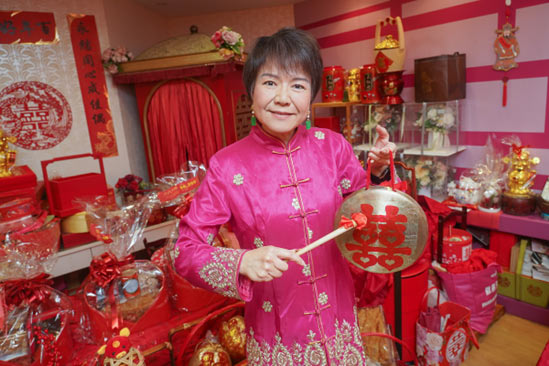
Sharon Au - Founder of the Hong Kong International Bridal Chaperone Association and Wedding Consultancy
Betrothal Ceremony
Guo Da Li is the formal act of “presentation of betrothal gifts” within the traditional Chinese wedding rituals known as the “Three Letters and Six Etiquettes”. Typically held 15 to 30 days before the wedding, it involves the groom’s family selecting an auspicious date to present betrothal gifts to the bride’s family as a sign of sincerity and respect, and officially confirm this marriage after bride’s family accepted. The gifts include dowry money, wedding cakes, and items in even numbers symbolising “good things come in pairs”. After the ceremony, wedding invitations and cakes are distributed to family and friends.
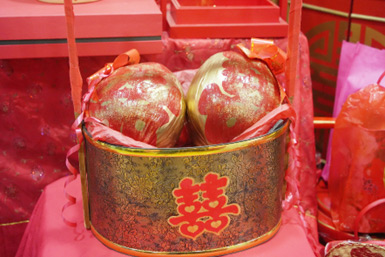
The gifts prepared by the groom’s family typically include items such as dragon and phoenix candles and cakes, couplet scrolls, coconuts, betel nuts, traditional Beijing sweets, tea leaves, dried seafood, fruit baskets, and fine wine. Modern versions of the ceremony may simplify this with an all-inclusive red envelope (lai see), and there are companies offering related services. The bride’s family traditionally prepares gifts like lotus root, pomegranates, kumquats, ginger, traditional snacks and tea sets for returning gifts. They also provide clothing items for the groom, namely trousers, belt, shoes, socks and wallet, but these can also be replaced with a red envelope (“groom's gold”). After receiving the groom’s gifts, the bride’s family returns half of the items, except for the money and cakes, of which only a small portion is returned.
[Tips]
Traditionally, the bride and groom should not participate in the Guo Da Li ceremony, and they should avoid seeing each other on that day. However, with changing times, it is now acceptable for the couple to meet after the ceremony is completed. Sharon explains that once the ceremony is over, it is no longer considered taboo, and the couple can take photos together to commemorate the occasion.
Setting the Bed
Before the wedding, the couple performs the "setting the bed" ritual, symbolising harmony, fertility, and prosperity. Since the bed cannot be slept on after the ritual until the wedding day, it is typically done the day before. The groom’s family usually provides the bed frame and mattress, while the bride’s family supplies the bedding. Traditionally, red is used to symbolise celebration, but in modern times, any colour except white, black, grey, or pink is acceptable to match home decoration.
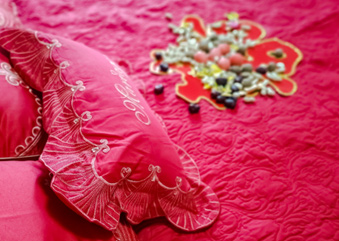
In addition to placing new bedding during the "setting the bed" ritual, auspicious items such as lotus seeds, longans, red dates, and sweets are also placed on the bed. Children, typically a boy and a girl, are invited to jump on the bed, symbolising the wish for the couple to have children soon and for those children to grow up strong and healthy.
[Tips]
Nowadays, many couples choose to perform the door-opening and door-closing rituals in hotels. Sharon reminds that since the "setting the bed" ritual symbolises blessings for a stable and harmonious marriage, it must be conducted on the bed at home.
Hair Combing Ceremony
The "hair combing" ceremony is a significant ritual in traditional weddings, symbolising that the couple is ready to start a family and embrace married life. It also signifies the couple’s wish to "grow old together." Usually perform at the night before the wedding, the bride and groom each carry out the ritual at their own homes. Traditionally, it is conducted by facing a window and the moon, as the Lunar God is the matchmaker who blesses the marriage.
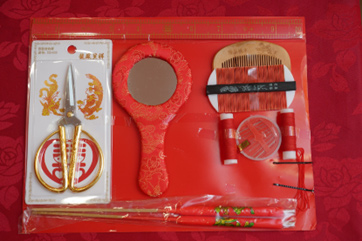
The "hair combing" ceremony is presided over by a "blessed person" (either a blessed man or woman), who must be in a harmonious marriage, with both spouses alive and with children. If the couple’s parents meet these criteria, they can perform the ceremony, or a Dai Kam Jie can do it. The bride’s ceremony must be conducted by a blessed woman, while the groom’s has no such restriction. The items used differ slightly between the bride and groom, which include a pair of dragon and phoenix candles and cakes, mirrors, combs, scissors, a special ruler, red string, cypress, glutinous rice balls, fresh fruit, and red envelopes. The bride also needs sewing supplies and cosmetic powder, while the groom requires a red waistband.
On the night of "hair combing" ceremony, the bride and groom change into new red pajamas. The "blessed man" or "blessed woman" combs their hair from the top down, reciting auspicious phrases with each stroke, "One stroke to the end of your hair, two strokes for grey hair together, three strokes for many children and grandchildren..." Traditionally, the hair was combed ten times, but now it is usually simplified to three. A red string and cypress are placed in the bride’s hair and in the groom’s pajama pocket. Afterwards, they eat glutinous rice balls together, symbolising a sweet and harmonious marriage.
[Tips]
Since each combing stroke must go from top to bottom without stopping, even if the comb gets caught in the hair, it cannot be pulled out midway. Therefore, Sharon advises the couple to have hair treatment before the "hair combing" ceremony to make their hair smoother.
Leaving the Bride's Home and Entering the Groom's Home
On the wedding day, the groom arrives at the bride’s home at an auspicious time to meet the bride. Nowadays, there is often a "groom’s challenge" to create a festive ambience. After passing the challenge and offering a red envelope, the groom receives the bride from her father, symbolising the father entrusting the groom with the responsibility of caring for his daughter. The couple bows to ancestors and their parents, offering tea before heading to the groom’s home. They then bow to heaven and earth, repeating the same rituals upon arrival. This symbolises the bride's formal entry into the groom’s household.
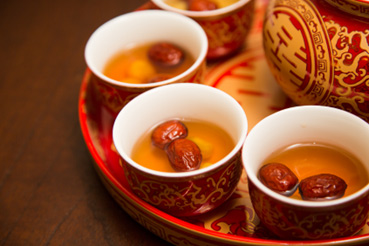
The tea ceremony is a way for the couple to express gratitude to their parents and elders. During the ceremony, the Dai Kam Jie or bridesmaids will say auspicious phrases such as, "After drinking the bride’s/groom’s tea, may you be blessed with wealth and honour." The usual order is to serve the parents first, followed by elders in accordance with seniority.
[Tips]
Red tea is typically used for the tea ceremony, with green tea being less common. Lotus seeds and red dates are added to the tea. The tea is not filled to the brim, symbolizing, "Tea poured to seven-tenths full, leaving three-tenths for affection."
Return to the Bride’s Home
The "return to the bride’s home" refers to the first visit the bride makes to her parents after the wedding. The groom brings gifts such as roast pig, fruit, and wine to express gratitude. The bride’s family returns the pig’s head, tail, and pork knuckle as a symbolic gesture of "a good beginning and a good ending." They also give sugarcane and auspicious vegetables to the groom’s family.
[Tips]
Traditionally, the "return to the bride’s home" takes place on the third day after the wedding, known as "the three-day return." The wedding day counts as the first day, and the third day is the second day after the wedding. Nowadays, many couples opt for a "same-day return." For example, if the bride leaves the hotel during the day and the banquet is held at the hotel in the evening, returning to the groom’s home and then back to the hotel counts as the same-day return. A roast pig coupon can also replace the actual roast pig.
The Qun Kua
On the wedding day, the bride wears the Qun Kua. The top is called "Kua" and the bottom refers to the long skirt. In the past, the bride’s mother would sew the Qun Kua by hand to bless her daughter. Traditional Qun Kua is embroidered with auspicious patterns using gold and silver thread, like dragons, phoenixes, peonies, pomegranates, butterflies, and lucky clouds. The density of the embroidery indicates its value, with five levels: "Kua Wong" with nearly 100% density, "Kua Hou" with around 80%, "Great Five Blessings" and “Median Five Blessings” with 60% and 50% respectively, those with embroidery density lower than 50% are regarded as “Mini Five Blessings”. Recently, modern designs incorporating materials like crystals and sequins have become popular.
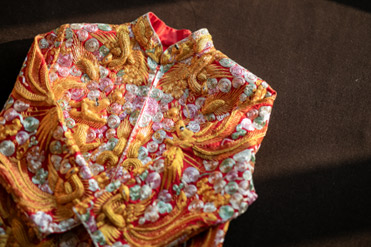
[Tips]
There is a common belief that the Qun Kua can only be worn once, but Sharon explains that this is not entirely accurate. Some brides wear the Qun Kua when leaving home in the morning, change into a wedding gown for the ceremony at noon, and then wear the Qun Kua again for the tea ceremony in the evening, which is totally acceptable. However, as best practice, when trying on the outfit, the top and skirt are usually tried on separately rather than together.